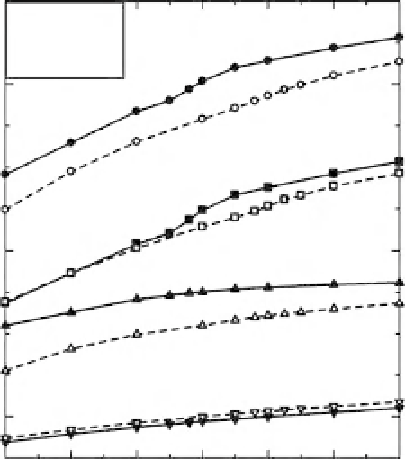Geoscience Reference
In-Depth Information
the origin of mantle heterogeneity is a key to clar-
ifying not only the nature of mantle dynamics but
also the evolution history of the Earth.
So far, two major causes of deep mantle het-
erogeneity, lateral (isobaric) thermal and compo-
sitional variations, are proposed (e.g., Lay
et al
.,
1998; Trampert
et al
., 2004; Nakagawa & Tack-
ley, 2005; Bull
et al
., 2009; Lassak
et al
., 2010).
Geochemical observations suggest the presence
of chemically distinctive materials in the deep
interior particularly from the source regions of
ocean island basalts (e.g., Hofmann, 1997). How-
ever, the spatial distribution of these anomalous
materials is not well constrained by the geochem-
ical observations and a range of models have been
proposed (e.g., Tackley, 2000).
The best recognized heterogeneity in the deep
mantle is the degree-2 anomalies at the bottom of
the mantle (e.g., Dziewonski, 1984; Romanowicz,
2003). Recent fluid dynamics simulations showed
that those could be formed by accumulating the
dense MORB material on the core-mantle bound-
ary (CMB) (e.g., Nakagawa & Tackley, 2005,
2010). In contrast, other numerical models report
that the observed large heterogeneous structures
can mostly be explained by a thermal anomaly
only (Schuberth
et al
., 2009) or the two het-
erogeneity mechanisms due to the thermal and
chemical anomalies are hardly distinguishable
seismologically within the current tomographic
resolution (Schubert
et al
., 2004; Bull
et al
., 2009;
Lassak
et al
., 2010) (see also Karato & Karki, 2001).
This kind of simulation usually applies several
empirical parameterizations for representing the
material's properties at deep mantle conditions,
and those uncertainties are reported to substan-
tially affect the simulated convection patterns.
For example, if a 3% density contrast is ap-
plied for two petrological end-members, MORB
and harzburgite, the bottom of the mantle is oc-
cupied almost entirely by MORB, which forms
large thermochemical piles, while a zero den-
sity contrast develops plume clusters (Nakagawa
& Tackley, 2005). In the lowermost mantle, it
is however still unclear what is the actual den-
sity contrast between peridotite (or pyrolite) and
MORB and what are the actual seismic wave
δ
-AIOOH
Phase D
V
P
12
V
Φ
8
V
S
ρ
4
0
10
20
30
40
50
60
P (GPa)
Fig. 7.8
Static elastic wave velocities and density
calculated for
δ
-AlOOH (solid lines) and phase D
(dashed lines) as a function of pressure. Nonlinear
behaviors are associated with the hydrogen bond
symmetrizations.
velocities to those of anhydrous mantle phases,
we see that the velocities of these dense hydrous
phases are never distinctly slower than those of
anhydrous phases. Therefore, these phases, if in-
cluded in the materials subducted into the lower
mantle, do not contribute to produce low-velocity
anomaly.
7.6
Insight into the Lower Mantle
Heterogeneity
In the convecting mantle, large-scale composi-
tional heterogeneity can be expected near the
boundary layers. In the Earth, the lithosphere in
the shallow mantle and the D
layer located at the
base of the mantle, are known to be largely hetero-
geneous both seismologically and geochemically
(e.g., Grand
et al
., 1997; Hoffman, 1997; Kellogg
et al
., 1999; M egnin & Romanowicz, 2000; An-
tolik
et al
., 2003; Humayun
et al
., 2004; Zhao,
2004; Takeuchi, 2007). Detailed understanding of

